This is a Praktica VLC 3, a 35mm Single Lens Reflex camera made by VEB Pentacon in Dresden, East Germany between the years 1976 and 1981. The Praktica VLC 3 was the successor to the short lived Exakta RTL 1000 and part of the 3rd Generation of the Praktica L-series. With other cameras in the series, it shares it’s body, vertically traveling metal blade focal plane shutter, TTL metering, and support for Pentacon’s new electronic M42 lenses which communicate lens aperture to the body via three electrical connections in the lens mount. It was the last VLC model however, as there was no equivalent in the succeeding 4th Generation. All three VLC models are unique among other Prakticas as they feature both interchangeable viewfinders and focusing screens.
Film Type: 135 (35mm)
Lens: 50 mm f/1.8 Pentacon electric Multi-Coated coated 6-elements in 4-groups
Lens Mount: M42 Screw Mount w/ Praktica electric contacts
Focus: 1.1 feet / 0.33 meters to Infinity
Viewfinder: Interchangeable SLR Pentaprism w/ Match Needle Display
Shutter: Vertically Traveling Metal Focal Plane
Speeds: B, 1 – 1/1000 seconds
Exposure Meter: Coupled TTL CdS Cell w/ viewfinder match needle
Battery: 4.5v PX21 / 523 Mercury Battery
Flash Mount: Accessory Clip with M and X Flash Sync, X-Sync 1/125
Other Features: Self-Timer, Shutter Readiness Indicator
Weight: 808 grams, 612 grams (no lens), 526 grams (no lens no prism)
Manual (in every language except English): https://www.cameramanuals.org/praktica_pdf/praktica_vlc3-languages.pdf
Manual (similar model, English): https://www.cameramanuals.org/praktica_pdf/praktica_vlc2.pdf
How these ratings work |
The Praktica VLC 3 was one of the higher end Prakticas, featuring open aperture metering via electric connections back to the lens, an interchangeable viewfinder, and a vertically traveling metal focal plane shutter with speeds up to 1/1000 second. This, being the third VLC model has a soft and grippy body covering that makes it very comfortable to hold during long shooting sessions. This camera won’t win any awards for a long feature set, but what it does do, it does very well. The Meyer-Optik designed Pentacon electric lens delivers great results, in a body that is familiar and comfortable to use. If there was only one Praktica you were going to use, this would be a good one. | ||||||
| Images | Handling | Features | Viewfinder | Feel & Beauty | History | Age | |
| 2 | 2 | 1 | 1 | 1 | 1 | 0% | |
| Bonus | +1 for the complete package, an unassuming winner | ||||||
| Final Score | 9.0 | ||||||
History
If you were to ask someone to name the most successful camera brands from the 20th century, specifically 35mm SLRs, I have to assume that names like Nikon, Canon, Zeiss, Leica, or perhaps Minolta, Olympus, or Pentax would be the most common responses. Yet, according to Mike Otto’s excellent Praktica collection website, over 7.7 million Prakticas were produced between 1949 and 2001, making them one of the most successful and longest lived 35mm SLR marques in the history of the industry.
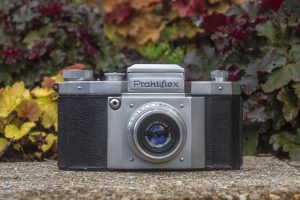
Tracing it’s roots to other East German based camera makers like Kamera-Werkstätten Guthe & Thorsch (KW) and Zeiss-Ikon Dresden, the Praktica evolved from a camera called the KW Praktiflex, released in 1939. The Praktiflex was designed by Alois Hoheisel and was the second German made 35mm SLR, second to the Ihagee (Kine) Exakta. Unlike the Exakta, which was a complex and feature rich camera, the Praktiflex was very basic. Featuring a simple focal plane shutter, 40mm lens mount, and a fixed waist level finder, the Praktiflex opened the door to what was then considered “new” 35mm film. It sold for around 120 Reichsmarks, which put it within reach of the amateur photographer.
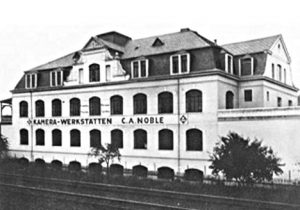
Unlike many German optics manufacturers, KW continued production of the Praktiflex throughout the course of World War II, offering it in variety of military and civilian versions. Despite being generally regarded as a “Dresden area” maker, KW’s primary factory was not actually in Dresden, but rather a nearby suburb called Niedersedlitz where it escaped damage from Allied bombing raids on Dresden in early 1945. It was this good location that allowed KW to be the only German maker of cameras still in operation immediately following the war.
Dresden is in what would become Soviet controlled East Germany, and all nearby camera companies would fall under the jurisdiction of the Soviet government. In 1948, KW would officially be reorganized VEB Kamera-Werkstaetten Niedersedlitz. The abbreviation VEB stands for Volkseigener Betrieb which translates to ‘Publicly Owned Operation’ in English and was the main legal form of industrial enterprise in East Germany from the late 1940s until the early 1960s. In late 1945, the government controlled Soviet Military Administration in Germany (SMAD) would set an annual production goal of 50,000 cameras by the KW factory, a number that was unattainable, largely due to the hand crafted precision parts required for their cameras.
In January 1946, SMAD would transfer a prominent engineer from the nearby Zeiss-Ikon factory named Siegfried Böhm to KW in an effort to help improve the speed and efficiency of it’s output so they could meet their lofty goals. Böhm’s first changes involved a simplification of the Praktiflex’s design and a switch of the lens mount from a proprietary M40 to an all new M42 design. The revised camera was called the Praktiflex II and could be made faster and cheaper than the original model.
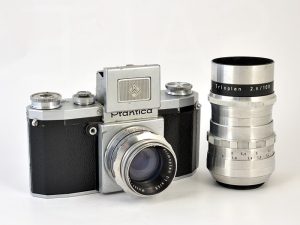
In addition to the revised Praktiflex, in 1949 Böhm introduced a completely new model called the Praktica which was similar to the Praktiflex, but had more modern controls, the larger 42mm screw mount originally designed by Zeiss-Ikon Dresden for their Contax SLR, a simpler shutter, and could be sold at a price that was within the reach of most amateur photographers. The Praktica was an immediate success, helping to reestablish KW as a premiere maker of German built 35mm cameras. Although considered a modern camera at the time, early Prakticas still lacked many features we take for granted today such as a pentaprism viewfinder, auto returning mirror, or any sort of metering or electronics.
In 1952, a revised model called the Praktica FX was released which added flash synchronization and a few minor improvements. The name Praktiflex was re-used for export versions of the Praktica, but otherwise was identical, and would be the last time the name “Praktiflex” was used. There would be many subtle revisions of the FX-series throughout the 1950s, but they would all retain the same basic feature set of a cloth focal plane shutter, waist level finder, and knob wind film advance.
The first major revision to the Praktica ‘s design came in June 1959 with the release of the Praktica IV. Featuring the lineup’s first ever pentaprism viewfinder, the Praktica IV was finally able to compete with the growing number of high quality Japanese and German SLRs being made at this time. Other advancements to the Praktica IV was an all new bottom wind film advance, a revised rewind knob, and an automatic diaphragm. Several revisions of the IV would be released adding features such as a Fresnel viewing screen, split image focus aide, and a selenium light meter.

In 1964, during production of the Praktica IV, the East German government, in an effort to consolidate resources and workforce would combine nearly every Dresden area optics company into a single entity, known then as VEB Pentacon Dresden which would continue until the fall of the Berlin Wall in 1989.
In December 1964, a revised model called the Praktica V F would be released that would be identical to the models before it, only adding an instant return mirror and adopting the modern system of numbering shutter speeds (i.e. 30, 60, 125, 250, etc). Models with and without a meter were available as well. Both the Praktica IV and V models were produced concurrently until January 1966 and were both the first Prakticas exported to the United States in large numbers.
Around the same time the Praktica V F was released, another completely redesigned model called the Praktica nova made it’s debut. The nova series were the first models released under the company’s new organization as VEB Pentacon Dresden, and had a more compact and modern body as compared to the earlier IV and V models. Gone was the awkwardness of the large pentaprism and the bottom film advance lever. In their place was a smaller prism with top plate film advance lever, and a new angled front shutter release. Still in the approximate same location as the earlier Prakticas, the shutter release was more ergonomic, more closely matching the one on the Zeiss-Ikon Contax SLR.
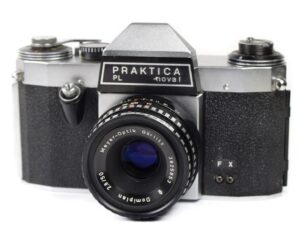
The nova was further improved in 1967 as the Praktica PL nova. Externally, the nova and PL nova look very similar but the PL models had a new stationary shutter speed selector that no longer rotated as the shutter fired, and had a new quick loading film system. A total of 12 different variations of the PL novas were produced through 1976, many of which were exported to other countries with names like the Cavalier SLR-II, Hanimex Praktica nova, Pentor IB, Porst FX4, Revueflex SL, and others. Also, during this series, the first models with electronically controlled shutters and TTL CdS meters began to appear.
With the nova and PL nova series, the popularity of the Praktica was higher than ever before. Between 1964 and 1976, over 1.1 million cameras were produced, making it the most popular German camera (West or East), in the world, but the company’s best was yet to come.
By the end of the 1960s, most of the Dresden area optical industry had consolidated into a single entity, VEB Pentacon Dresden. Even Ihagee Kamerawerk, who managed to stay independent for many years after the war, eventually succumbed and merged with East Germany’s primary photographic powerhouse.
The current generation of nova and PL nova cameras were selling well and bringing much needed money into East Germany’s struggling economy, compared to more and more advanced models coming from Japan, the Prakticas still were far behind both in style and functionality, so it became clear that the company would once again need to go back to the drawing board and come up with something new if they wanted to continue and compete in the world market.
Turning to a young designer named Rolf Noack, the next Pentacon needed to look like and function like a camera that could sell just as well in Germany as it did the United States or Japan. A camera that would have German quality, good looks, and have a modern feature set. For this new camera, the engineers at Pentacon took notice of vertically traveling metal blade shutters like the Copal Square, which had been growing in popularity among Japanese camera makers.

Rather than copy the Japanese design, Pentacon built their own “type L” shutter, which would become the basis for the Pentacon L-series. In addition to a new shutter. the L-series would employ the greatest use of lighter weight materials like plastic compared to any previous Praktica models, and would also be the first to support open aperture metering where the lens could remain wide open without having to be stopped down first, while making an accurate exposure reading. The Pentacon L-series would be the single most successful and best selling of all generations of Pentacons, and would include no less than 49 different models which themselves are broken down into four different generations of the L-series.
If 49 different models within four generations of the Pentacon L-series sounds confusing enough, within each generation, submodels were further identified by a unique suffix to indicate which features it had. Within the first generation of the L-series were five submodels, they are:
- Praktica L – The most basic model, without a meter.
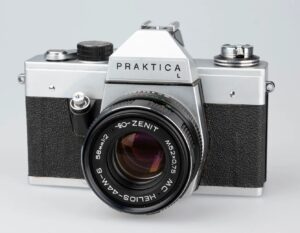
The Praktica L was the start of the L-series and was the most basic model, without a meter. - Praktica LB – The base model with an uncoupled body mounted selenium exposure meter.
- Praktica LTL – Improved model with a coupled TTL CdS exposure meter that requires the lens to be stopped down for an accurate reading. Also adds self-timer.
- Praktica LTL 2 – Same as the LTL but instead of a match needle, uses LEDs in the viewfinder.
- Praktica TL and Super TL 2 – Same as LTL but without the top 1/1000 shutter speed, no self-timer, and some other minor changes.
- Praktica LLC – More advanced metering system supporting open aperture metering via electronic simulation via Pentacon electric lenses.
- Praktica VLC – Same as the LLC, but adds an interchangeable viewfinder and focusing screen.
In 1975, the second generation of the L-series was introduced with several minor cosmetic changes including a plastic tip on the film advance lever, improved viewing screens in the viewfinder, and all models came standard with Multi-Coated lenses. The most significant change with the second generation is the addition of a model called the Praktica EE 2 which for the first time in a Praktica camera, added electronically controlled automatic exposure. The EE 2 also supported manual exposure, but via a smaller range of shutter speeds.
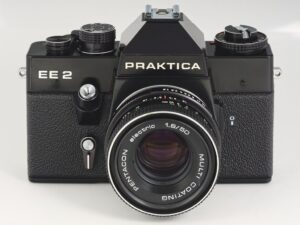
Like the first generation, the second generation had several submodels, most of which simply added a 2 at the end, except the LTL 2 which was part of the first generation, so the second generation was called the LTL 3.
- Praktica L 2 – The most basic model, without a meter.
- Praktica LB 2 – The base model with an uncoupled body mounted selenium exposure meter.
- Praktica LTL 3 – Improved model with a coupled TTL CdS exposure meter that requires the lens to be stopped down for an accurate reading. Also adds self-timer.
- Praktica DTL 2 – Very rare variant of the LTL 3 which also ads LEDs in the viewfinder like the first generation LTL 2.
- Praktica PLC 2 – Replaces the LLC, but retains nearly the same feature set including support for open aperture metering using Pentacon electric lenses.
- Praktica VLC – Same as the PLC 2, but adds an interchangeable viewfinder and focusing screen.
- Praktica EE 2 – Top of the line model with open aperture metering and electronic automatic exposure.
1978 saw the release of the third generation. Like with the second generation, most changes were cosmetic with minor functional changes. The highlights of this generation are flash hot shoes on all but the VLC 3, brighter viewing screens with Fresnel pattern to increase brightness, split image viewfinder with microprism collar focus aides, addition of + and – symbols in the viewfinder for the meter, and an all new rubberized elastic non-slip body covering.
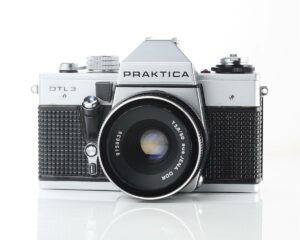
The third generation saw the two lowest models, the L and LB discontinued so now all Prakticas have some type of TTL coupled meter. The Super TL returned as the Super TL 3, skipping the second generation, and was effectively the base model with stopped down metering, no self-timer, and a top shutter speed of 1/500.
- Praktica Super TL 3 – Base model with no stop down TTL metering, no self-timer, and a top shutter speed of 1/500.
- Praktica MTL 3 – Instead of calling the LTL 3 the LTL 4, they renamed it MTL 3 to keep the numbers consistent, otherwise the same features as the LTL 3.
- Praktica DTL 3 – Same as MTL 3 but with LEDs in the viewfinder.
- Praktica PLC 3 – Same features as the PLC 2 with open aperture metering using Pentacon electric lenses.
- Praktica VLC 3 – Same features as the PLC 3 with open aperture metering using Pentacon electric lenses, plus interchangeable viewfinder, no hot shoe.
- Praktica EE 3 – Same features as the EE 2 with open aperture metering and electronic automatic exposure. Only model in third generation without the new rubberized elastic non-slip body covering.
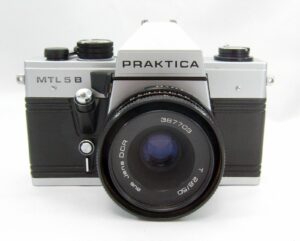
The fourth generation of the L-series would debut in 1980 and would be the longest produced, staying in production until December 1989. The fourth generation made it’s debut months after the release of the all new Praktica B-series, which replaced the venerable M42 screw mount with an all new Praktica bayonet mount. Along with the bayonet mount came further development of electronic shutters, automatic exposure, and even an auto focus prototype. Once the B-series made it’s debut, it took the place as Praktica’s premiere lineup of cameras, delegating the fourth generation of the L-series for economy models only. As a result, the more advanced models like the EE 3, VLC 3, and PLC 3 were all discontinued. The only notable changes to the fourth generation was on the MTL 5B an improved focus aide in the viewfinder with a double split image and a smaller microprism circle.
- Praktica Super TL 500 – The base model, replaces the Super TL 3, still featuring the top 1/500 shutter speed, no self-timer, and stop down TTL metering.
- Praktica Super TL 1000 – Same as the Super TL 500, but adds a top 1/1000 shutter speed.
- Praktica MTL 5 – Same features as MTL 3, but adds a new leatherette body covering with horizontal stripes across the top and bottom.
- Praktica MTL 5B – Same as the MTL 5, but adds the new double split image focus aide and smaller microprism circle.

After the conclusion of the fourth generation Prakticas, no other models would be made using the M42 screw mount. Bayonet mount Prakticas would continue through the 1990s with the final model, the Praktica BX 20s produced until 2001. A prototype Praktica BY series would be announced in 1989 which would expand on the B and BX series, adding auto focus and more advanced metering modes. The BY series would never be produced, most likely due to the collapse of the Berlin wall and the Soviet government who ruled East Germany.
The model being reviewed here is the VLC 3, the last of the VLC cameras, and the last screw mount Praktica that you could call “premium”. For many people “premium” and “Praktica” were mutually exclusive. For photographers all over the world, the Praktica name was synonymous with “value”, especially in the United States. When a Praktica was sold there, it was almost always the lowest end models, aimed at the beginner who wanted an SLR camera but without the SLR price tag.
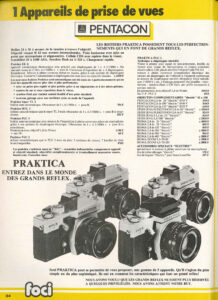
In East Germany, and other European countries, Prakticas were an easier sell. To have a higher end model like a VLC 3 made much more sense, and that is where I believe most, if not all were sold there. A few hints to this are found right in the user manual, which every version I’ve seen is printed in multiple languages. The manual for the VLC 2 has an English section, but the VLC 3 omits English entirely, suggesting an attempt to sell the camera in the UK was never made.
According to Mike Otto’s excellent Praktica page, the entire VLC series was one of the lowest selling of all L-series cameras. Sales of the original VLC, VLC 2, and VLC 3 were around 15,000, 40,000, and 30,000 respectively. This total of 85,000 VLC Prakticas pales in comparison to the entire L-series of which over 4.8 million were made.

In the French language ad to the left showing various models, the VLC 3 is listed, but without a price. The auto exposure EE 2 had a price of 2000 F and was the most advanced, and the PLC 3 was the model right beneath it at 1190 F, a good estimate of the price of the VLC 3 would probably be around 1500 F.
I could not find any English language ads for the VLC 3, however the September 1981 ad to the right from Cambridge Camera Exchange in New York City, the previous VLC 2 model sold for $143.95 which is probably close to what the VLC 3 would have sold for. When adjusted for inflation, this compares to about $470 today.
After the Praktica VLC 3, the era of screw mount Praktica came to a close. With the release of the new B-series and it’s bayonet mount, there was no longer a need for a higher spec camera. For the rest of the 1980s, all screw mount Prakticas were low end models without a lot of features, and very little new.
In the 1990s, after the reunification of Germany, Pentacon would stick around, and eventually wind up under the ownership of Jos. Schneider GmbH, makers of Schneider-Kreuznach lenses. Under Schneider’s leadership, new BX models would continue to be released with more ergonomic plastic bodies. In 1998, the ownership of Pentacon would change once again to a new entity called Pentacon GmbH which existed until as recently as 2020, however their website is no longer functional, suggesting they might have closed down.
Today, Praktica cameras are almost impossible not to collect, usually because of how common they are. Unfortunately, many Prakticas are easily dismissed as rudimentary relics of Soviet controlled East Germany, but some models are quite nice. I’ve written favorably about both the Praktica IV F and V F models, and I feel the same way about the VLC 3 model here. These models might not have the glowing reputation of Japanese SLRs from the same era, nor the classic beauty and over the top build quality of other West German SLRs, but they certainly are not bad cameras. Praktica models have earned their place in history and also in your collection.
My Thoughts
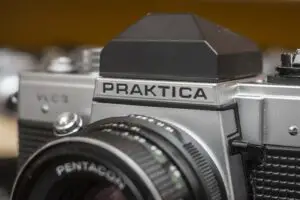
There are probably very few people out there who ever have the thought, “Gee, I should add more Prakticas to my collection”. It’s not that there’s anything wrong with Prakticas, in fact, they’re generally pretty solid, albeit basic performers and with the Zeiss lenses that are usually found on them, are just as capable of making great shots as nearly everything out there.
I think the reason you don’t see too many Prakticas on too many wish lists is both due to their utilitarian designs and how common they are. Millions of Prakticas were made from the very first KW Praktiflex based models in 1949 all the way to the BX series which ended production around 2001. With rare exception, Prakticas rarely pushed the envelope of innovation with new features, and usually were not marketed to professional or enthusiast photographers.
It has been well over four years since my last review of a Praktica model, when I looked at both the Praktica IV F and V F, two models which I gave high marks for their excellent build quality, unique top and bottom film advance, unusually large and bright prism viewfinders, and excellent optics. In the years since I’ve stumbled upon a few other models that I thought looked interesting, but not until I saw the Praktica VLC 2 did I seek one out to review.
As seems to happen in this hobby, within days of receiving the VLC 2, I found an even less common VLC 3. As was typical of many VEB Pentacon cameras like the Praktica, not many things change between models, so the VLC 2 and 3 are nearly identical, but one difference was in the body covering. Where the VLC 2 has a somewhat ordinary looking pebbled leatherette, the VLC 3 has a very unique rubberized body covering that looks like it’s made of pebbled bumps in a grid pattern. I had to have one, so within a 7 day period, I went from zero VLCs to two. For the rest of this section, I will describe the features of the VLC 3, but unless I say otherwise, the features are the same as on the VLC 2.
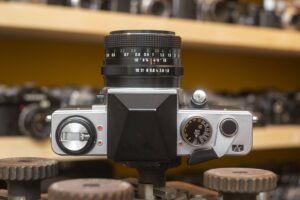
Up top, the camera is dominated by the large black removable pentaprism. A signature feature of the VLC series which was not available on any other Praktica was it’s removable prism. To it’s left is the rewind knob with folding handle. The knob also functions as the film door release, so pulling up on it and giving it a firm tub will release the door latch, allowing access to the film compartment.
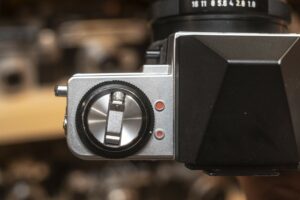
Beneath the rewind knob is a dial which the Praktica’s manual calls “Automatic Exposure Control”. This name is misleading as the camera does not have what we would consider Automatic Exposure today. The Praktica VLC series is a match needle camera and requires the user to manually control both the selection of shutter speeds and diaphragm f/stops on the lens. What this feature actually does is allow for open aperture metering, in which the camera can still give an accurate match needle reading at all f/stops even with the diaphragm wide open. In order to support this feature, you must use a compatible “Pentacon electric” lens which has electrical pins that mate with corresponding contacts in the lens mount. Only with these lenses, does the lens communicate back to the meter what f/stop you have selected.
With this dial pointing to the larger circle, the camera will meter with these electronic lenses wide open, while still giving you an accurate reading. If you’ve mounted any other “automatic” M42 screw mount lens that does not have these electronic contacts, you can still obtain an accurate meter reading by first turning this dial to the smaller circle and then manually stopping down the lens by setting the lens to Manual mode. You can also use older preset M42 lenses by manually selecting whichever f/stop you want to meter at. If you use a non-electronic “automatic” M42 lens that lacks an Auto/Manual switch, you will be unable to obtain an accurate reading.
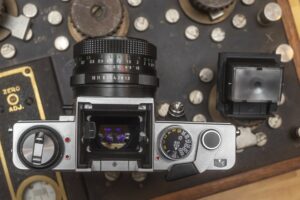
In the center is the interchangeable prism. The prism is held on by a black button on the left side of the mirror box, near the rewind knob. Simply press this button in and lift up on the entire prism to remove it. The original Praktica VLC was based off the earlier VEB Pentacon Exakta RTL 1000 which used a similar mount. Although I have previously reviewed this camera, I no longer have it, so I cannot check to see if the prisms are interchangeable, but I’ve read that they are, but only the non metered ones.
No metered prisms were available for the VLC as the camera already has a meter in the body. For the VLC 3, the only options are the standard prism, a magnified loupe viewfinder, and a waist level finder. Like the original Ihagee Exakta that this camera’s prism is based off, the focusing screen is built into the bottom of the viewfinder. Removing the viewfinder also removes the screen, so unlike most other cameras with interchangeable viewfinders, it is not possible to use the camera at waist level by simply removing the prism. You’d need the actual waist level finder designed for this camera to take waist level shots. The focusing screen is made of plastic and can be swapped out for a few others that were available.
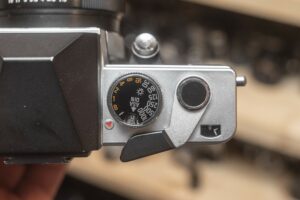
Next to the prism is the combined shutter and film speed dial. Changing shutter speeds is done by rotating the entire dial from 1 to 1/1000 seconds. Past the 1 second mark is a B for Bulb and a flash symbol for 1/125. The speed selector cannot go straight from the flash symbol to 1/1000, you must rotate it the opposite direction. Changing film speeds is done by first lifting up on the outer perimeter of the dial and then rotating it while looking at film speeds through a small window in between the flash and 1000 setting. Film speed options are available in both ASA and DIN from 12 to 1600 and 12 to 33 respectively.
Next is the film advance lever, which has a black plastic cap on the tip for comfort, a feature that did not exist on the original VLC model. A full motion of the lever requires about a 180 swing, and must be done in one single motion. Smaller intermittent motions are not allowed. Finally, on the far edge is the automatic resetting exposure counter. The counter is additive, showing how many exposures have been made on the current roll, and is automatically reset when the film door is opened.

Around back, there’s little to see other than the rectangular eyepiece for the prism viewfinder and a large swath of the bumpy rubber body covering. The eyepiece has grooves around it’s edges for use with some viewfinder accessories that were available for the camera.
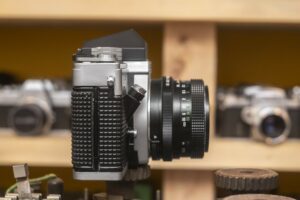
The sides of the camera are rather plain, with a flash sync connector on the camera’s left side and metal strap lugs on both sides. The presence of strap lugs is convenient as it means you do not need to rely on the camera’s original case to use a strap. From this side of the camera, you get a good look at the angle of the front shutter release, which was changed from a flat shutter release button on earlier Prakticas.
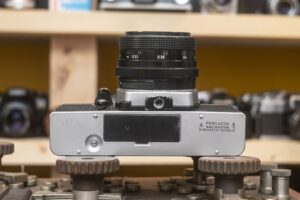
The bottom of the camera is dominated by a large plastic door that covers the battery compartment for the 4.5v PX21 / 523 Mercury Battery. Since mercury batteries are outlawed in most countries, finding modern day equivalents for this size has become a challenge. A few companies like Exell make alkaline equivalents, but they’re expensive and depending on where in the world you live, might be difficult to obtain. Thankfully, an alternative is to use a AA Alkaline battery, which despite them only being 1.5v compared to 4.5v still works fine. I’ve tried it on both my VLC 2 and 3 models and it powers up the meter on both. One consequence of the lower voltage is that it takes the needle a much longer time to settle on a reading, but once it stops moving, the reading is correct. So if you intend on shooting one of these cameras and don’t have the correct battery, but want the try the meter, you can substitute a regular AA battery as long you have a little bit of patience.
With the battery taking up a large part of the base, the 1/4″ tripod socket was relocated forward to a plate beneath the mirror box, which is ideal, as it still allows for good balance with the camera mounted to a tripod. To one side is the rewind release button, and on the other is writing that says “Pentacon Made in German Democratic Republic”. Flanking this writing is the Pentacon Ernemann tower logo and a number 1 symbol indicating VEB Pentacon’s highest level of quality assurance.
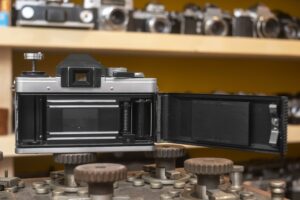
Opening up the right hinged film door reveals a mostly modern film compartment. Film transports from left to right onto a non removable plastic and metal take up spool which uses a type of quick loading system which is unique to Pentacon cameras of this era. I’ll admit to being a little puzzled at how it works the first time I attempted to load film into the camera, but once you get used to it, it works well.
The first step to loading film is to pass the film leader behind a plastic panel that covers the lower sprockets on the exposure counter shaft. The film must go behind this panel or else it will not transport correctly. With the film correctly threaded behind the panel, you’ll notice that the plastic take up spool has two metal bars that loop around the entire spool on opposite sides. The purpose of these bars is to hold the film steady on the take up spool as it is advanced. With this system, there is no need to attach the film leader to the actual spool, simply push enough of the leader under one of the two bars so that it passes through to the complete opposite side and then advance the film with the lever. Doing this causes the spool and the two bars to rotate clockwise, putting pressure on the leader and pulling it behind the spool.
I am certain this sounds complicated in words, but in practice, it is very easy to do, in fact, I actually like this system better than others I’ve seen, and I wish more cameras employed something similar. In case my description is difficult to understand (I don’t blame you), I made a short video showing how it’s done.
The rest of the film compartment is pretty standard, a black paint body with twin bare metal film rails above and below the film gate, and an oversized film pressure plate with divots help reduce friction as film passes over it. The metal blades of the vertically traveling focal plane shutter are also visible. Pentacon made their own shutters, and although this one is based off an earlier design, it is much more reliable than earlier Pentacon shutters. Inside the hinge of the film door is a foam light seal which has degraded and needs replacement, however the door channels above and below the film gate are made of black yarn and were still in good condition. The camera’s serial number is also engraved into the metal on the inside of the door hinge.
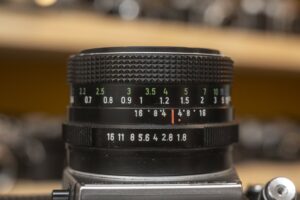
The lens on this VLC 3 is branded Pentacon electric 1.8/50 and based on my research is based on the Meyer-Optik Görlitz Oreston 50mm f/1.8 lens. There were at least four versions of this lens, all optically the same, with the differences being the external appearance. This copy is the third variant and is said to be less common than the fourth variant. Regardless of which version you have, they all work the same. Closest to the body is the aperture ring with click stops from f/1.8 to f/16. In front of it is a fixed depth of field scale with a red IR index on the right setting for f/4. Nearest the front is the focus ring which has focus scales in metered engraved in white and in feet engraved in green. The focus ring on this example is all metal with a raised spike pattern and turns smoothly with just the right amount of resistance so as not to feel cheap, but also isn’t difficult to turn. The front of the lens has a threaded 49mm filter ring.
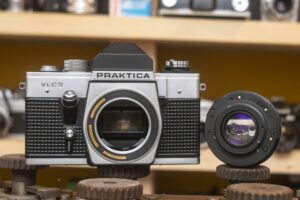
The Praktica features the M42 “Universal Screw Mount” and physically accepts nearly every M42 lens ever made. You could mount a Zeiss Tessar from the original 1949 Praktica to it, along with any number of screw mount lenses made by any German, Japanese, or Soviet company and it would work fine. If you want to take advantage of the metering features however, you need a lens that at least has an automatic diaphragm and a switch to manually stop down the lens. Some Yashinon M42 lenses lack this switch so would not work with the VLC 3 meter. If you want maximum compatibility, you need one of the Pentacon electric lenses that has three electrical contacts on the back of the lens, that when screwed onto the body, touch three brass contact points in the lens mount. These contact points transmit the selected aperture of the lens so that the meter can accurately calculate exposure using whatever f/stop you’ve selected.
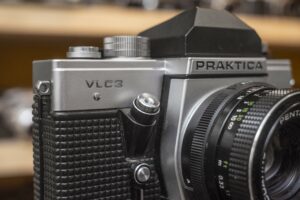
To the left of the lens mount is the front angled shutter release which is threaded for a cable release. This style of angled front releases was a design characteristic of Praktica cameras from the mid 1960s and on. replacing the more traditional buttons of the earlier models. It is slightly more comfortable than the front button cameras, but somewhat negates your ability to stabilize the camera while pressing the shutter release. Below the shutter release is the mechanical self timer and self timer release button. To activate the self timer, rotate the lever clockwise as far as it will go and cock the shutter. With the self timer set, pressing the shutter release will not activate it. Instead, you must press a chrome button in the center of the self time to begin an approximate 8 second countdown. There is no way to cancel the self timer once it is set, but you could just keep using the regular shutter release and it will stay set until you need it again.
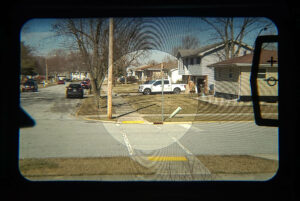
The viewfinder is a mix of good and not so good. On the upside, the screen is bright enough to be able to focus on anything in all but the worst light. I had no problems seeing all four edges of the screen while wearing prescription glasses. A very large match needle with + and – indicators dominates the right side of the viewfinder. The match needle on this camera is one of the largest I’ve ever seen. This particular example has a microprism focus aide in the center, surrounded by a ground glass circle, and then a prominent Fresnel pattern extending to the edges. The Fresnel screen is made of very noticeable circles. They do allow you to focus all the way to the edges and show minimal vignetting near the corners, but this all comes at the expense of overall brightness.
Compared to SLR cameras from the 1960s to early 1970s, the brightness of the VLC 3 screen would be acceptable, but considering this model was in production from 1976 to 1981, this is quite dark for a camera that could be bought new in the 1980s. One additional feature that was also present on the Praktica V F I previously reviewed, is a triangular flag which appears on the left of the screen when the shutter is not cocked. After cocking the shutter, this flag disappears, indicating the shutter is ready to fire.
A characteristic of nearly every Praktica ever made was it’s utilitarian ruggedness. These are generally well built cameras that support a wide range of good to great lenses, but without a lot of fanfare. With the Praktica L-series, specially, the VLC models, the Prakticas improve their ergonomics and feature set, somewhat allowing them to compare favorably with contemporary cameras. These are certainly no Nikon or Canon SLRs, but they’re also not as cheap as some people suggest they are. The VLC 3 was the pinnacle of the screw mount Prakticas, it feels great in your hands, is easy to use, and has all the features you need to make great images, without much else to get in the way. But is that enough though? Keep reading…
My Results
For my first roll of film through the Praktica, I had an expired roll of Kodak Technical Pan that was donated to me by friend and Camerosity Podcast co-host, Anthony Rue. I was excited to see how Tech Pan looked in it’s special developer compared to my beloved Kodak Panatomic-X. I shot the roll of film and set it aside to develop it in a high contrast homemade developer called POTA.
As promised, the Tech Pan plus POTA combination produced images with eerily high contrast. Muddy black and blown out highlights were present in nearly every image giving an otherworldly look to the images. I am generally a fan of medium to low contrast films as I prefer many layers of shadow detail, the consolation of this film is the incredibly high resolution of the film with almost no grain. The sharpness of the Pentacon lens was put to good use with this lens and is a combo I wouldn’t mind revisiting again. I do not have much Kodak Tech Pan however, so I wanted to see what the camera was capable of with a more mundane film, so I went with a fresh roll of Fuji Color 200.
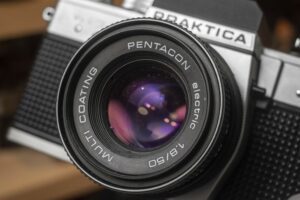
In an early draft of this review, I had assumed the Pentacon electric was a rebadged Zeiss Jena lens, possibly like a Pancolar, but as I would later learn, this is either a straight rebadge, or a reformulation of the Meyer-Optik Görlitz Oreston 50mm f/1.8 lens. Whichever it is, the lens compares favorably to most f/2 and under 50mm lenses I’ve shot.
Sharpness across the frame is excellent without any signs of vignetting. A very tiny amount of softness begins to creep in near the edges, but only in some images. I noticed that wide open, this lens is a bit soft, but nothing that you wouldn’t expect from a lens of this class. Overall, I would say the Pentacon electric is a fine lens, if a bit sterile as every metric I could come up with to describe this lens is “good, but not great”, but that’s not always a bad thing.
The Pentacon VLC 3 was an enjoyable camera and in use, contradicts a pervasive opinion online that these are all simple cameras not worth your time. There is a lot to like about these later L-series Pentacons, specifically the VLC 3.
The signature feature of the VLC 3 is it’s interchangeable viewfinder, however it’s design is similar to that of the Ihagee Exakta in which the focusing screen is part of the viewfinder, so removing the viewfinder also removes the screen. This means unlike other cameras with interchangeable viewfinders like the Nikon F-Series and most Miranda SLRs, you cannot use the camera at waist level simply by removing the prism. Using the VLC 3 at waist level requires that you own the actual Waist Level Finder made for it, which are very rare and hard to find. This somewhat negates the primary reason to get a VLC model as opposed to the fixed prism LLC and PLC models. Still, the black prism is attractive and gives the camera a look that other Prakticas don’t.
In use, the one on the VLC 3 isn’t quite as bright as laser etched ground glass screens found on cameras like the Minolta XD11 or Nikon F3, but that’s not a fair comparison. For an East German SLR with roots dating to 1969, the Praktica VLC 3 has good and very usable viewfinder which I had no problem seeing while wearing prescription glasses.
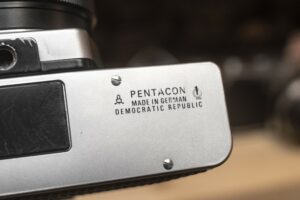
By far, my favorite feature of the camera is actually it’s body covering. I think this might be the first time I’ve declared my love for a body covering, but the one on this camera has a feel that no other cameras have. Despite being over 40 years old, the covering on this example is not peeling, cracking, and is still as soft and rubber-like as it likely was when it was new. This gives the camera a reassuring grip and comfort that would suggest it to be a good option for long shooting sessions.
In use, the Pentacon VLC 3 is an excellent camera. It does everything I needed it to do, without anything I didn’t. Whether this is the first or the tenth Praktica you’ve shot, the controls feel familiar and modern at the same time. I repeat in many of my reviews my fondness for front shutter releases like those found on Miranda SLRs and other rangefinder cameras like the Auto Terra Super. The angled release of the Praktica feels sort of half-way between a front and top plate shutter release. I don’t know that angling it made it any better or worse than earlier Prakticas like the IV F and V F which aren’t angled. At the very least, it gives the Praktica VLC 3 a unique feel that few cameras have.
If you’re looking for a classic fully mechanical camera with advanced features like auto exposure, LCD displays in the viewfinder, or data backs, the VLC 3 is not for you. If however, you appreciate a classic heavy, fully mechanical tank to take with you with familiar controls and good ergonomics, this is the camera for you. If you want something better than the Pentacon electric 50mm f/1.8 lens and don’t mind stop down metering, then you can use pretty much any M42 screw mount lens ever made. This is a fun camera, and so far has proved itself to be a reliable shooter, and one I’ll likely take out again.
Related Posts You Might Enjoy
External Links
http://www.praktica-collector.de/204_Praktica_VLC3.htm
https://www.dresdner-kameras.de/praktica/praktica.html#L (in German)
https://www.i-do-photography.com/2018/08/02/praktica-vlc-series/
https://www.collection-appareils.fr/x/html/appareil-4313-Pentacon_Praktica%20VLC3.html


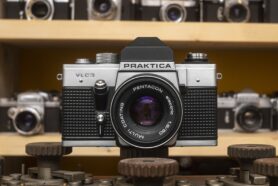
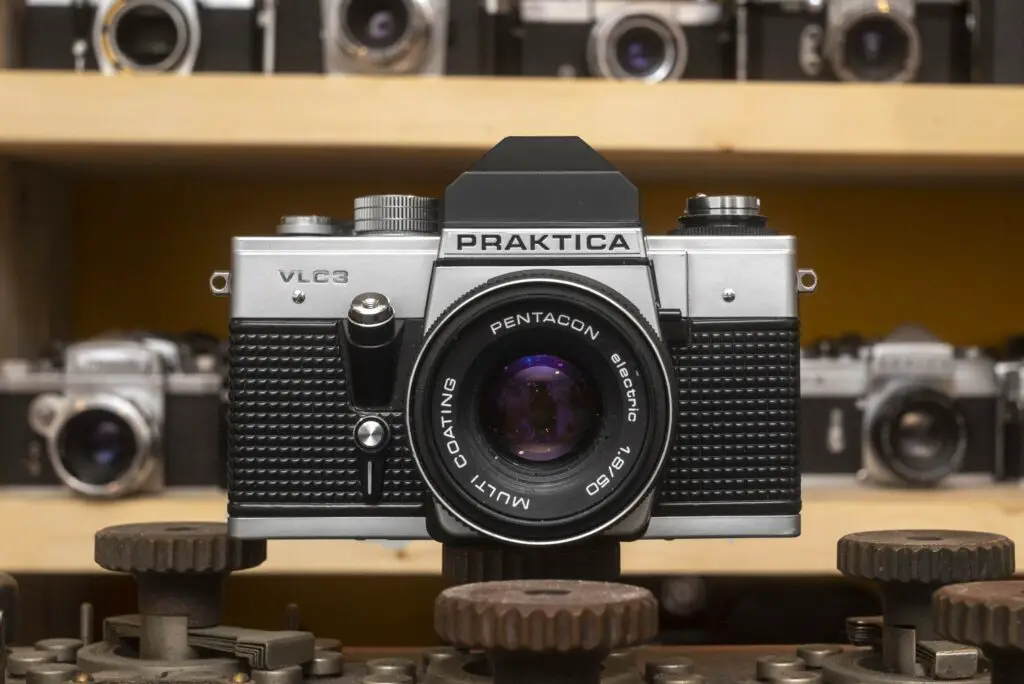






























Thanks for the detailed look at these tough, underappreciated cameras. You did miss one whole variant in the L-series, the DTL2/3 and the MTL50, which substituted LEDs for the match-needle display, another attempt to keep up with the Japanese.
Also, it’s worth noting the the LLC/PLC/VLC cameras were the very first cameras to use an electrical linkage between camera and lens, something that is commonplace today. Also, there are electric versions of the Carl Zeiss Jena lenses, though prices on those have soared in the last ten years or so.
These cameras could take a lot of abuse and still work. Severe cold? No problem. The 70’s models did what they said on the tin with no frills. Different lenses could be added and with the old M42 fitting there is a lot of good glass out there. Personally I like using the Takumars on mine.
Great read- as always. If you judge by feel- solidity, smoothness of action, visible machining,etc. many of the early Prakticas are superb and well made. Yet long term experience showed that they weren’t durable at all when used for more than very light duty. But, many cameras that don’t feel nearly as nice are far more durable.
Very interesting and well-done review of this often under-appreciated camera, Mike! In 1973, I bought my brother a Praktica LLC in East Berlin, while I was stationed in the Army Band in Berlin. Fortunately, I was able to buy one with the Zeiss 50mm f1.8 Pancolar. What a great combo this was! The detail in the images was easily discernible from those of the Meyer 1.8 on my Exakta RTL. I really liked the Praktica, and with the electric lens contacts, it was a breeze to use. Unfortunately, my brother sold it without consulting me (the nerve!) as I would have gladly bought it, and I’d probably still have it.
A really great read and veritable resource of information. My first camera in 1984 was an MTL3 for GBP50. I wondered what the difference was with the MTL5 – just the leatherette! I was self-conscious as a teenager with a boxy metal, low cost camera, but they are built to last.
I specifically purchased the PLC3 for my CZJ Flektogon 35/2.4 electric, and I think the lens and camera body are a perfect match. There’s nothing better than using the Flektogon 35/2.4 at full aperture… and I only spent $22 on it.
Camera models with the letter “C” can use electric version lenses.